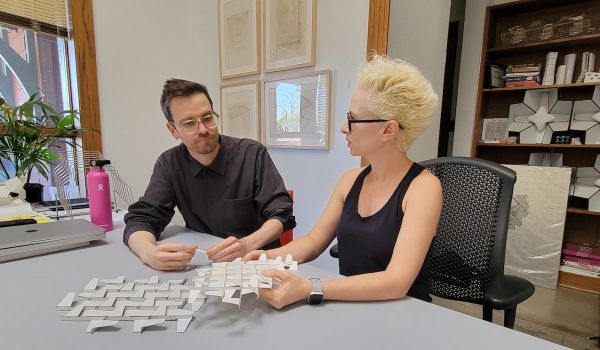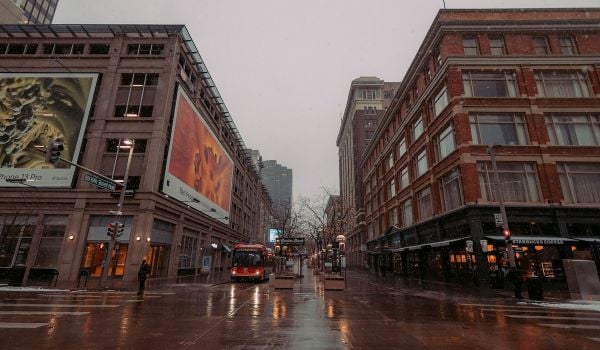When my family moved to Tucson from Denver in 2000, we left a gentrifying turn-of-the-century neighborhood in northwest Denver for a turn-of-the-next-century “sustainable” New Urbanist community in southeast Tucson. At the time, Tucson seemed to be on the cutting edge of sustainable development—Civano was the poster child for energy efficiency, landscape salvaging, and indigenous architectural styles.
Denver certainly had its share of wonderful old neighborhoods—Washington Park, Congress Park, and West Highlands to name a few—but new, cutting-edge neighborhoods were rare back then. There was, for example, the redevelopment of the Elitch Gardens amusement park called Highlands’ Garden Village, a small neotraditional community up in Boulder named Iris Hollow, and a Modernist, New Urban development called Prospect New Town up in Longmont. But even Prospect, which perhaps held the most promise, was an unknown because of its exurban location and the wild mishmash of architectural styles. Otherwise, single-use suburban sprawl was the norm.

“Typical” Modernist architecture in Prospect New Town. Photo by Simmons Buntin.
Now just eight years later, Civano has become just a ghost of its original promise, few other developments in Tucson have lived up to their sustainable promise (Mercado District at Menlo Park and Armory Park del Sol the two most notable exceptions, perhaps), and the city planning and development services departments struggle to enable mixed-use and alternative development because the old, segregated land use code still reigns supreme.
The metropolitan Denver area, however, has become America’s greatest urban canvas. And last week I had the opportunity to tour many of the region’s New Urban and older urban neighborhoods, thanks to fellow urban planning school grad and current planner and marketing strategist Carolyn Dooling. Well before I arrived on Sunday morning—under the auspices of seeing Elvis Costello and The Police at the Red Rocks Amphitheater the following Tuesday evening—Carolyn had mapped out our route. Turns out that even though her husband Joe is an architect, he doesn’t enjoy spending hours on end touring new, mixed-use developments. His loss, because Carolyn is an energetic and knowledgeable guide, and she has worked in some capacity on many of the projects we visited.
We started in Stapleton, where Carolyn and her family live. Though the Stapleton Redevelopment Foundation was created in 1990, a year after Denver voters approved construction of Denver International Airport to replace Stapleton International Airport, it wasn’t until 1995 that the initial development plan was produced. Six years later, Forest City Enterprises began construction, and today more than 3,000 of the planned 12,000 homes and apartments are built. When complete, Stapleton’s 4,700 acres—which includes a 1,116-acre regional park system—will be home to 30,000 residents and support 35,000 workers. The numbers on this “infill” project are astounding, though less so considering it is the largest urban infill project in the country. For example, over 21,000 street trees had been planted by 2007. Six million tons of runway concrete have been recycled into new sidewalks, roadways, bridges, and bike paths. One-hundred percent of the homes are ENERGY STAR qualified. And the pedestrian-oriented plan calls for over 81 miles of sidewalks.

New homes facing one of Stapleton’s many small parks. Photo by Simmons Buntin.
By the end of my first full morning, I felt like I had already walked half of those sidewalk miles. Though Stapleton’s architecture is diverse, beautiful, and energy-efficient—both for individual homes and for entire neighborhoods—what sets Stapleton apart (beyond its sheer size) is the vast amount of integrated open space. Many new communities set aside large tracts of open space, but they’re often pushed to the side and feel secondary, or at least notably separate. At Stapleton, however, the Sand Creek and Westerly Creek Greenways run the length and width of the project, and feature both natural and landscaped areas. Throughout, there are pocket parks, large and more formal parks, and other amenities such as the 123-acre Bluff Lake Nature Center and the Urban Farm at Stapleton, a 23-acre community farm and environmental education facility.
But the amenities and resource-efficient homes within walking distance of neighborhood schools, corner stores, distinct public art, and larger commercial districts do not come cheap. The least expensive single-family homes I saw started in the mid-$300Ks, and while I haven’t verified it, the average price of new or resale seems about $650K. Though Stapleton offers apartments, lofts, and townhomes, affordable housing is a fleeting idea at best.

There’s plenty of open space, much of which includes hardscaping from recycled airport runways, at Stapleton. Photo by Simmons Buntin.
View an online gallery of Stapleton images at http://www.simmonsbuntin.com/images/gallery/2008/nu/stapleton.
Next we visited Bradburn Village, the current UnSprawl case study over at Terrain.org: A Journal of the Built & Natural Environments. Bradburn is located in Westminster, a sprawling city along U.S. Highway 36, halfway between Denver and Boulder. Though largely a bedroom suburb, Westminster’s city council had actively sought more pedestrian-oriented development at least since I served as a planning commissioner from 1997 to 1998. Bradburn, developed by Continuum Partners, fits the bill, though at only a fraction of the size of Stapleton. The 125-acre project features four small neighborhoods and a village core that is now about half built out. As with Stapleton, however, Bradburn offers plenty of open space. Not only does it abut Westminster’s extensive Dry Creek Open Space trail system, it also features nine pocket parks.

One of the Craftsman-style homes at Westminster’s Bradburn Village. Photo by Simmons Buntin.
Perhaps because of its size, Bradburn felt both quainter and more comfortable than Stapleton, something my guide Carolyn acknowledged almost regretfully, perhaps because a similar house costs some $200K less up here. Petra Spiess, a Bradburn resident and author of the Terrain.org case study, welcomed us into her home as she compared the two projects. In the end, it was a matter of both location and cost for her and her husband, who both work from home. Unlike Tucson, which has suffered greatly by the downturn in the real estate market, Bradburn and indeed all of the Denver region’s New Urbanist communities are faring well, with the exception of the very high-end custom homes, which are selling much more slowly, if at all.
Though it’s difficult to judge Bradburn’s village core because only a couple blocks are built so far, I applaud its elegant central church, its collection of 40 solar homes by McStain Homes (the largest solar community of single-family homes in Colorado), and the overall mix of uses, including live-work and nearby multifamily housing. Given the surrounding area’s segregated, suburban makeup, Bradburn Village stands out perhaps more than the city would like, yet it is entirely possible and hopeful that it will serve as a design influence on the surrounding area.

Denver Square and Farmhouse vernacular at Bradburn Village. Photo by Simmons Buntin.
View an online gallery of Bradburn Village images at http://www.simmonsbuntin.com/images/gallery/2008/nu/bradburn.
We finished our first full day by driving up to Longmont’s Prospect New Town, a mixed-use development built on the site of a former tree farm by owner/developer Kiki Wallace. Though this was my third visit to Colorado’s first New Urbanist community, I had not previously spent as much time onsite, even though I wrote a brief case study on it for Terrain.org just before moving to Tucson. At 80 acres, Prospect is only two-thirds the size of Bradburn Village, and yet it feels larger—in many senses it feels larger than life, given the Modernist and otherwise highly eclectic architecture and mix of uses. The site plan was created by celebrated town planners Duany Plater-Zyberk & Company, but the architecture is rarely neotraditional, especially in the second and third phases of the project, which at buildout is expected to house nearly 2,000 people.

Though not a requirement, there’s a certain advantage to owning a wildly colored car in wildly colored Prospect New Town. Photo by Simmons Buntin.
Carolyn and I began the afternoon by having lunch at Two Dogs Diner, recommended by Petra. The diner and the broader Prospect “downtown” did not disappoint. Located along U.S. Highway 287, Prospect’s commercial area is readily accessible from the main north-south thoroughfare of the area, yet deep within the neighborhood there’s also a town square, which not surprisingly is actually triangular, around which is a mix of single-family attached and detached homes and a corner restaurant reminiscent of the many corner stores and restaurants in older Denver and Boulder neighborhoods. Though The Rib House couldn’t meet our needs for ice cream on-the-go, Prospect did meet our expectations for sheer delightfulness. Though the neighborhood is clearly less child-welcoming than Stapleton or Bradburn Village, it’s far more colorful and, in many senses, innovative. By the end, Carolyn and I were both scheming how we could sell our homes in similarly important New Urbanist communities to move here. From a resale perspective, Carolyn would fare much better (Prospect’s homes also seem to average about $650K), but on the other hand if I can’t sell my soul to live in a delightful neighborhood like Prospect, what’s the point in selling my soul at all?
And soul is what Prospect and, indeed, Stapleton and Bradburn Village are all about. Each place is distinct—each of the many neighborhoods in Stapleton is itself unique, too—but they have created a sense of place that in many new developments is often lacking. And that sense of place, that crisp feel of the authentic gives soul to its residents, workers, and visitors.

Never a dull moment, at least visually, in Colorado’s first New Urban neighborhood. Photo by Simmons Buntin.
Just take a look at some of the photos in the Prospect New Town online gallery to see how much soul the place and its buildings have: http://www.simmonsbuntin.com/images/gallery/2008/nu/prospect.
~~~~~~
In my next entry, we’ll explore Lowry in Denver, Belmar in Lakewood, and Iris Hollow and the Holiday Neighborhood in Boulder.















